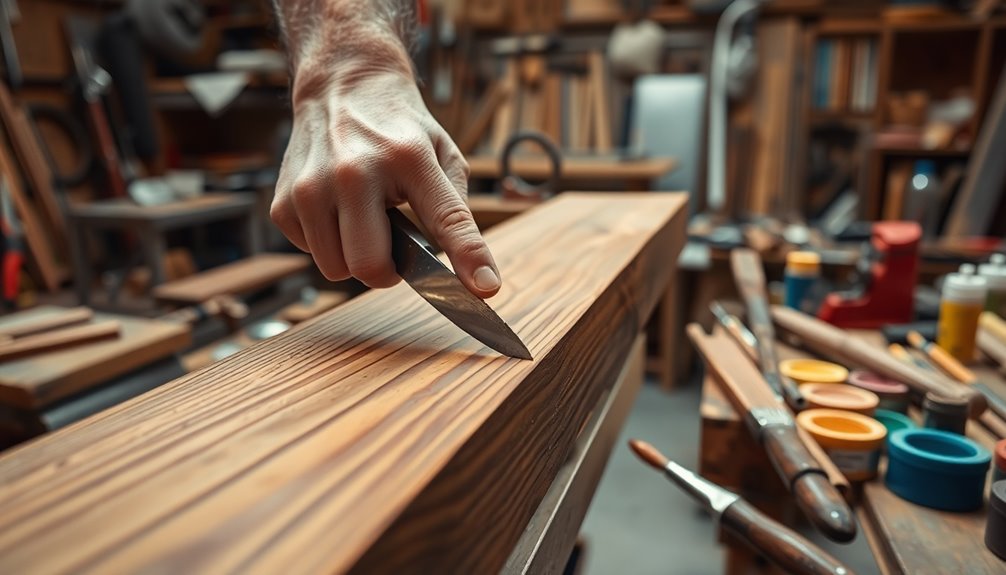To master your DIY craft, start with small, manageable projects to build your confidence. Equip yourself with essential tools like hammers and drills, and always wear safety gear. Learn fundamental skills such as measuring and cutting accurately, and familiarize yourself with basic plumbing and electrical tasks. Don't forget to document your progress and seek support from local workshops or online communities. Keeping track of your achievements will inspire you to take on even bigger challenges ahead!
Key Takeaways
- Start with small, manageable projects to build confidence and gradually tackle more complex tasks as your skills improve.
- Invest in quality tools and regularly maintain them to achieve professional-looking results and streamline your workflow.
- Utilize online tutorials and join local workshops to learn new techniques and gain hands-on experience from experts.
- Familiarize yourself with basic plumbing and electrical skills to save money and enhance your DIY capabilities safely.
- Document your projects and track progress to stay motivated and celebrate your achievements along the way.
Getting Started With DIY Projects

Getting started with DIY projects can be an exciting journey, and it all begins with the right mindset. To build your confidence, it's essential to start small. Tackle manageable tasks like hanging shelves or painting a room.
These projects help you develop important skills without feeling overwhelmed. Familiarize yourself with online resources, such as tutorials and videos, to learn techniques and gather inspiration.
Invest in quality tools like a hammer, screwdrivers, and a tape measure; they make tasks easier and guarantee better results. Embrace the learning process by practicing basic skills like measuring, cutting, and assembling furniture.
This solid foundation will prepare you for more complex projects in the future, making your DIY journey enjoyable and rewarding.
Essential Tools for Every DIYer
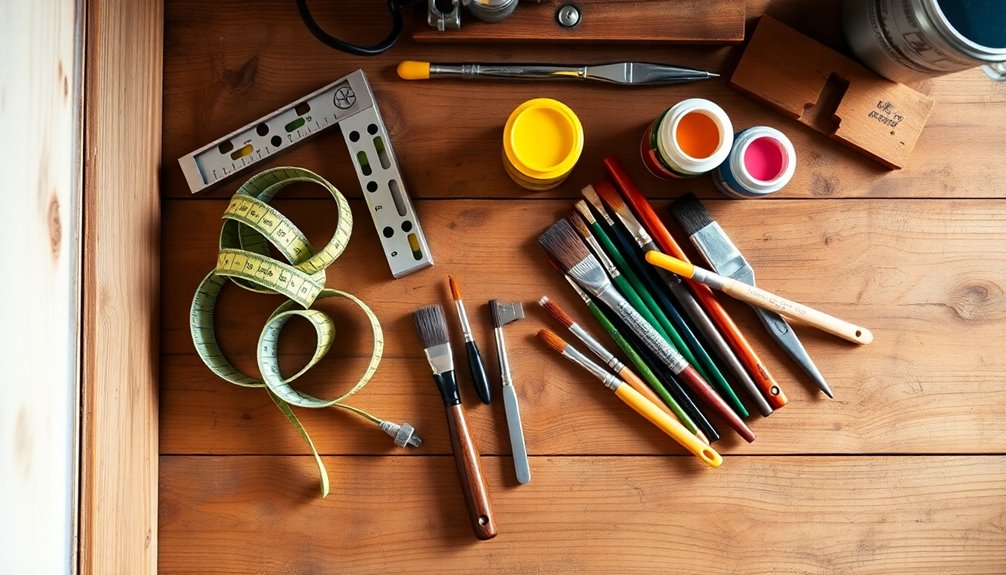
Every DIYer needs a solid set of tools to tackle projects with confidence and efficiency. A well-stocked toolbox is essential for success and should include both hand tools and power tools.
Investing in quality essential tools not only leads to better results but also enhances safety, minimizing the risk of accidents.
Here's a list of must-have tools for your toolkit:
- Hammer
- Flathead and Phillips screwdrivers
- Tape measure
- Power drill
Mastering the use of these tools, like saw techniques and joining methods, is key to achieving professional-looking results. Additionally, understanding the importance of tool maintenance can significantly improve your DIY experience.
Plus, regularly maintaining and organizing your tools can streamline your workflow, making it easier to access what you need.
Start building your toolkit today!
Building Your Confidence in DIY
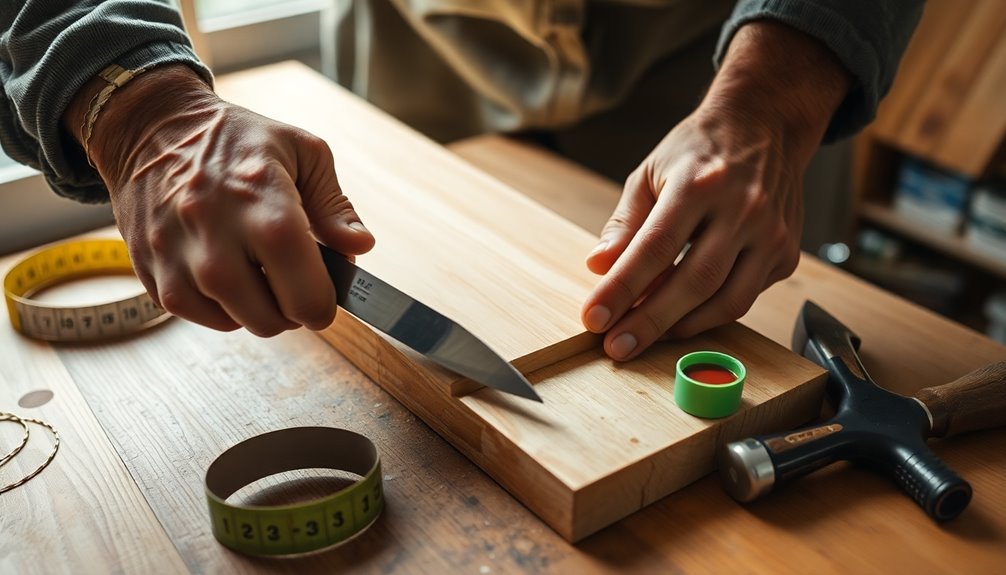
Building confidence in DIY projects transforms intimidating tasks into achievable goals.
Start with small, manageable projects like hanging shelves or assembling furniture. As you complete these tasks, you'll find yourself ready to tackle more complex challenges.
Utilize online tutorials and instructional videos to understand techniques better, making the process less overwhelming. Invest in essential hand tools like a hammer and screwdrivers; having the right tools makes a huge difference in building something successfully.
Track your progress by documenting completed projects, as seeing your achievements boosts motivation.
Finally, join local DIY workshops or community groups to gain hands-on experience. This support helps you overcome intimidation and fosters a sense of belonging, enhancing your confidence in your DIY journey.
Mastering Basic Carpentry Skills
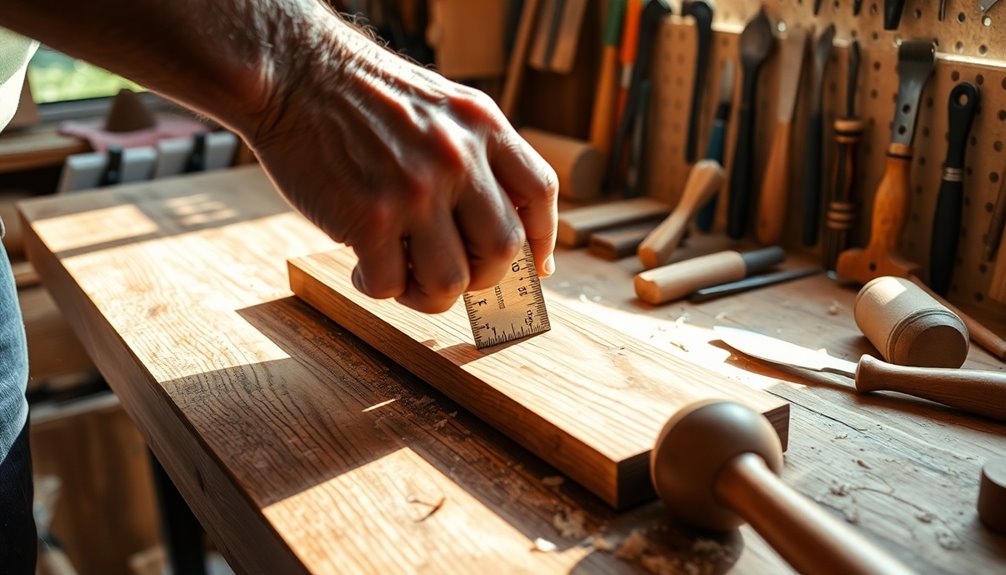
To master basic carpentry skills, you need to get comfortable with measuring and cutting wood accurately.
It's also important to learn various joining techniques, as they greatly impact the strength and look of your projects.
With practice, you'll gain confidence and precision, making your DIY endeavors more successful.
Measuring and Cutting Wood
Measuring and cutting wood accurately is essential for achieving successful carpentry projects. To guarantee precision, always use a tape measure and mark your measurements clearly.
Remember the principle "measure twice, cut once" to minimize waste and avoid mistakes. When cutting wood, select a sharp saw suited for your material and align the blade with your marks for clean cuts.
Here are some key tips to enhance your skills:
- Familiarize yourself with cross cuts and rip cuts.
- Use clamps to secure wood pieces safely.
- Wear safety goggles to protect your eyes.
- Check your measurements before cutting to prevent errors.
Joining Techniques and Methods
While mastering carpentry skills, understanding various joining techniques is essential for creating strong and durable structures. Start with basic joints like butt joints, lap joints, and dovetail joints.
Accurate measuring and cutting are critical, so always use a tape measure and miter saw for precision. Enhance your joining methods with fasteners like nails, screws, and wood glue; knowing when to apply each can greatly boost your project's strength.
Familiarize yourself with power tools like drills and saws, as they’re important for executing these joining techniques efficiently and safely. Additionally, incorporating natural materials into your projects can add both beauty and sustainability to your creations. Moreover, mastering the use of these tools will not only improve your skill set but also increase the scope of projects you can tackle. When upgrading your workshop essentials, consider investing in high-quality equipment that will last for years and enhance your overall productivity. Remember, a well-equipped workspace is crucial for turning your creative visions into reality.
Finally, practice through small projects—like building simple furniture or shelves—to build your confidence and mastery in these essential carpentry skills.
Understanding Plumbing and Electrical Basics
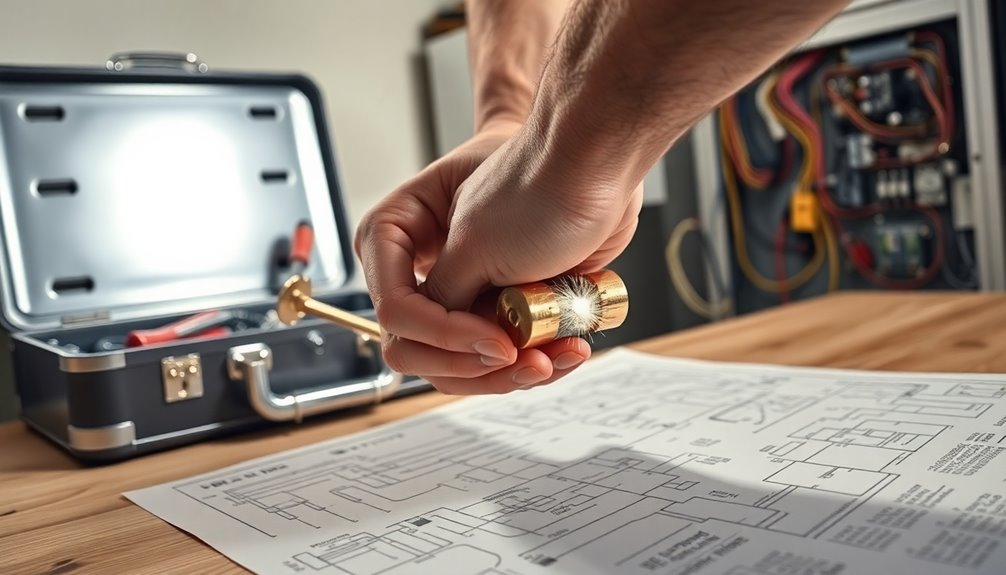
Understanding the basics of plumbing and electrical systems is crucial for any DIY enthusiast, as it empowers you to tackle common household issues with confidence. Knowing something about these systems can save you money and prevent potential hazards.
Here are a few key points to contemplate:
- Identify and fix common plumbing issues, like leaky faucets, using tools such as adjustable wrenches and plumber's tape.
- Recognize the different types of plumbing pipes—PVC, copper, and PEX—to select the right materials for your projects.
- Safely rewire light switches and outlets by turning off the power and using a voltage tester.
- Familiarize yourself with local electrical codes to guarantee compliance and safety in your installations.
These fundamentals will enhance your DIY skills considerably.
Expanding Your DIY Horizons
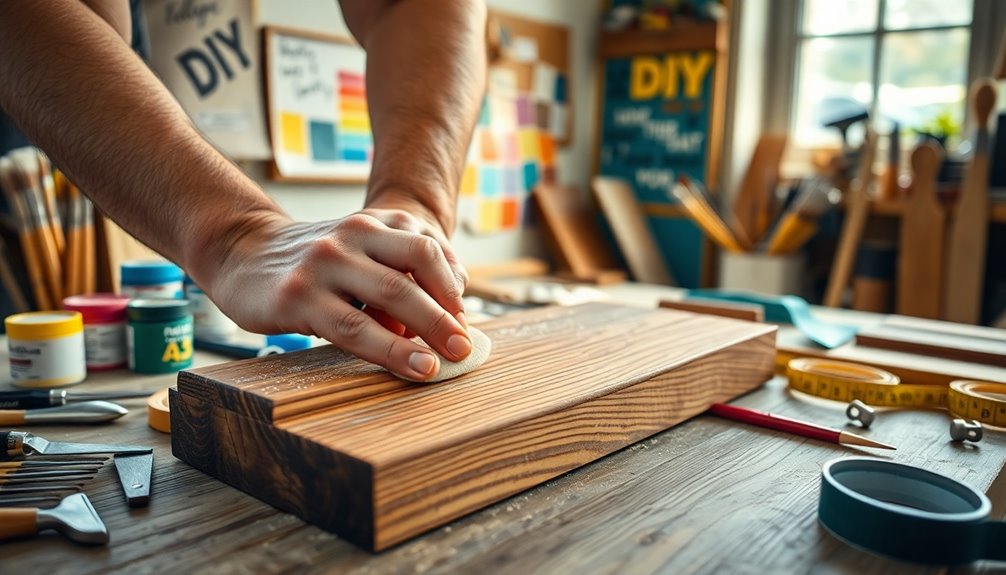
As you explore new DIY projects around your home, you'll find that expanding your horizons can lead to exciting transformations and personal growth.
Take control of your skills by tackling renovations in kitchens, bathrooms, or basements. These projects require knowledge in carpentry, plumbing, and electrical work, pushing you to learn and adapt.
You can also enhance your outdoor space by building decks or pergolas, which broadens your experience with various materials and techniques.
Embrace learning new skills like working with concrete or landscaping; these can elevate your DIY capabilities.
Utilize online tutorials and community workshops for insights and inspiration.
Stepping outside your comfort zone fosters creativity and problem-solving, making every project a rewarding experience.
Tackling Home Renovations With Ease

When tackling home renovations, start by planning your project thoroughly to guarantee you stay on track. Budgeting for improvements helps you manage costs effectively, while prioritizing safety precautions keeps you and your home protected. Additionally, understanding local building codes is essential to ensure compliance and avoid legal issues. With a solid plan in place, you can approach your renovations with confidence and ease.
Planning Your Renovation Project
Before diving into your renovation project, it's important to assess your budget and time frame. Careful planning helps you avoid overspending and delays.
Start by evaluating your skills and selecting projects that match your abilities. Remember, it's vital to prioritize proper execution by researching best practices for your specific renovation type.
For complex tasks like plumbing or electrical work, consider hiring professionals while managing simpler tasks yourself. Use your available space wisely, ensuring you're not overwhelmed.
- Set a realistic timeline
- Research necessary materials
- Seek guidance from home improvement store employees
- Create a project checklist
Additionally, consider creating a mood board to visually organize your design ideas and ensure a cohesive atmosphere throughout your renovation.
Budgeting for Home Improvements
Budgeting for home improvements is essential to guarantee your renovation project runs smoothly and stays within financial limits.
Start by evaluating your budget to cover materials, tools, and unexpected costs, adding an extra 10-20% for contingencies.
Creating a detailed project plan helps outline all necessary expenses, keeping you from overspending.
Research and compare prices from different suppliers to find the best deals, which can save you hundreds.
Consider the potential return on investment (ROI) for your projects, as improvements like kitchen remodels can yield over 80% ROI when selling.
Additionally, understanding your Roth vs. Traditional IRA options can help you allocate savings effectively for future home improvement projects.
Finally, track all expenses and keep receipts organized for clarity.
Successfully managing your budget not only guarantees financial control but also gives you a satisfying sense of accomplishment when you complete your project.
Safety Precautions to Consider
Safety is paramount in any home renovation project. To protect yourself and your home, always follow essential safety precautions.
Start by wearing appropriate personal protective equipment (PPE) like safety goggles, gloves, and masks. Before diving into renovations, turn off the electricity and water supply in the work area to avoid accidents.
Familiarize yourself with the tools and materials you'll be using; improper handling can lead to injuries. Finally, guarantee proper ventilation when using paints and solvents to prevent toxic fume buildup. Additionally, ensure that you are using proper priming techniques to achieve smooth paint flow and prevent clogging during your painting tasks.
- Wear PPE: safety goggles, gloves, masks
- Turn off electricity and water supply
- Read instruction manuals for tools
- Guarantee proper ventilation when using chemicals
Outdoor DIY Projects to Enhance Your Space
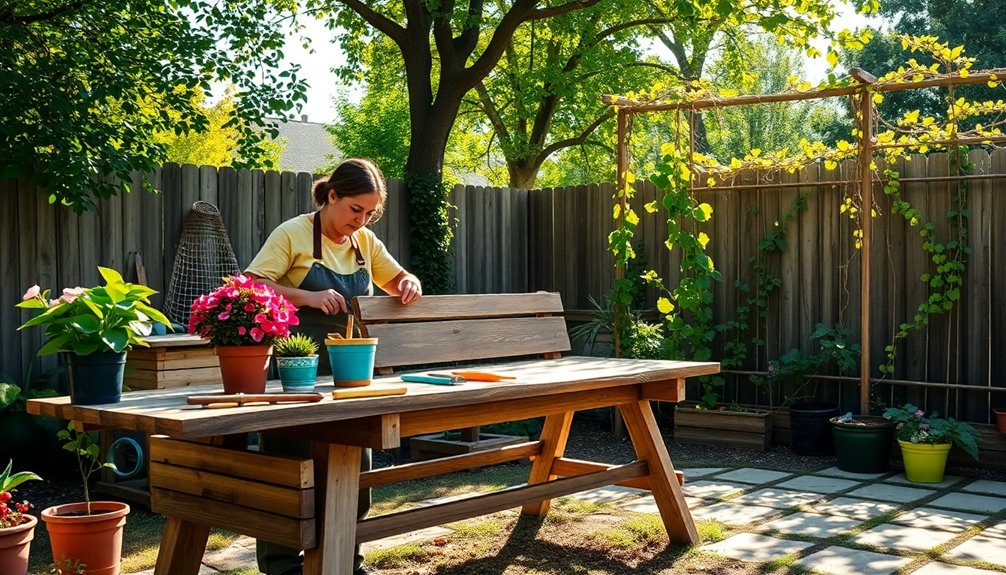
If you're looking to elevate your outdoor space, tackling a few DIY projects can make a notable difference.
Start with simple projects like building a raised garden bed; it enhances your yard's beauty and promotes sustainable gardening. You could also create a backyard patio or deck, extending your living area for entertaining or relaxation.
If you want to add tranquility, consider installing a water feature like a pond or fountain, attracting wildlife while fostering a serene atmosphere.
Designing a pergola or arbor provides shade and a stylish focal point, perfect for supporting climbing plants.
Each of these projects not only boosts your home's curb appeal but can also increase its overall value notably. Additionally, engaging in these outdoor projects can lead to enhanced emotional well-being as you create spaces that encourage relaxation and connection with nature.
Utilizing Resources and Community Support

When you tap into available resources and community support, your DIY journey becomes much more enjoyable and effective.
By leveraging various platforms, you can enhance your skills and connect with others who share your passion. Here are some ways to utilize these resources:
- Check out YouTube tutorials and DIY blogs for step-by-step guidance.
- Attend local workshops for hands-on learning with experienced instructors.
- Join DIY communities online or in-person for support and collaboration.
- Engage with social media forums to troubleshoot challenges and share tips. Additionally, consider using bold colors for accent walls to energize your projects and inspire creativity.
Tracking Progress and Celebrating Success
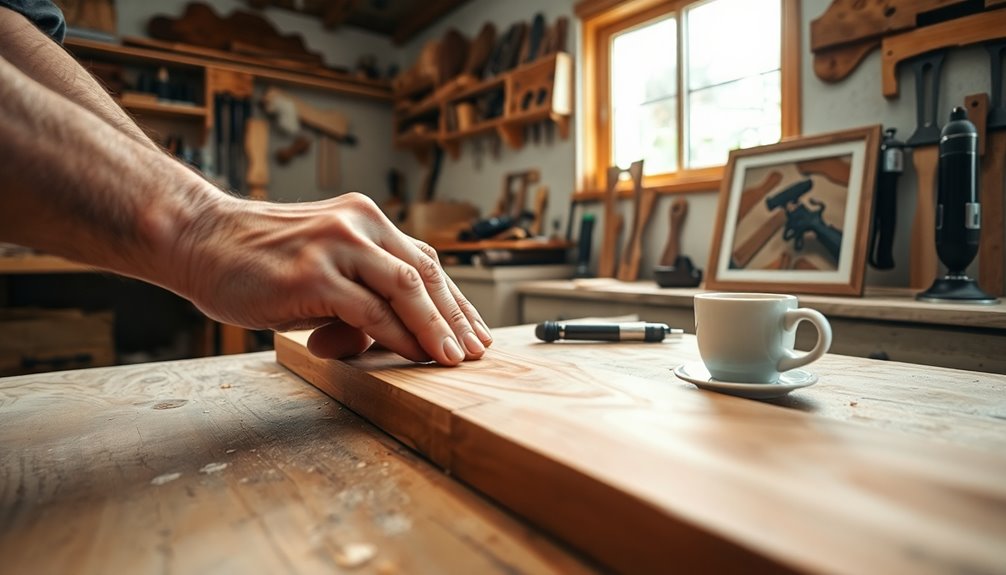
Tracking your progress is key to staying motivated in your DIY projects.
By celebrating small achievements and documenting your journey, you can truly appreciate how far you've come.
Plus, sharing your successes can inspire others and keep you connected to the DIY community.
Visible Progress Tracking
While managing a DIY project, keeping an eye on your progress can be a game-changer for motivation and commitment.
By incorporating visible progress tracking, you can visually document your achievements and stay engaged.
Utilize these tools to enhance your experience:
- Project timelines: Set clear deadlines for each phase.
- Completion percentages: Track how much of your project is done.
- Progress charts: Create visual representations of milestones.
- Calendar updates: Schedule regular check-ins to assess your skills. Additionally, consider integrating color accuracy techniques to ensure that your visual documentation is as vibrant and engaging as possible.
Celebrate Small Achievements
Visible progress tracking not only keeps you motivated, but it also sets the stage for celebrating small achievements along your DIY journey. When you successfully hang a shelf or finish a painting project, take a moment to acknowledge your effort.
These small victories foster a positive mindset and encourage you to dive deeper into your DIY tasks. Utilize calendars or checklists to visualize your progress, making it easier to see how far you've come.
Don't forget to reward yourself for completing even minor projects; this creates a cycle of motivation that prepares you for bigger challenges. Sharing your completed work with friends or online communities can amplify the sense of achievement, inspiring both you and others to continue exploring DIY adventures. Additionally, incorporating techniques for self-reflection can further enhance your understanding of your growth and areas for improvement throughout your projects.
Documenting Your Journey
Documenting your DIY journey not only keeps you organized but also allows you to celebrate your accomplishments along the way. By tracking your progress, you can see how far you've come and what you need to improve.
Whether you're aiming to create something special for your living room or tackling smaller projects, consider these tips:
- Keep a project journal to note tasks and challenges.
- Set specific milestones and celebrate when you reach them.
- Use photos to visually track your progress.
- Share your experiences with DIY communities for support and inspiration.
Regularly reviewing your documentation boosts your confidence, helping you recognize the skills you've developed. Celebrate each step, and let your journey inspire future projects!
Frequently Asked Questions
How to Become a Master at Your Craft?
To become a master at your craft, focus on deliberate practice. Aim for consistent, focused sessions that build muscle memory and improve your skills.
Don't shy away from seeking mentorship; guidance from experienced individuals can accelerate your learning and help you spot weaknesses.
Embrace failure as a learning opportunity, and cultivate a growth mindset by setting specific goals.
Each project should serve as a stepping stone toward greater expertise, enhancing your overall mastery.
How to Become a DIY Expert?
Did you know that 75% of DIY enthusiasts say they've gained confidence by completing projects?
To become a DIY expert, start by gathering essential tools like a hammer and screwdrivers. Master basic carpentry techniques—accurate measuring and cutting are key.
Use online tutorials and local workshops to learn continuously. Track your progress by documenting completed projects, and don't shy away from mistakes; they're essential for growth.
Embrace challenges, and you'll see improvement in no time!
How Long Does It Take to Master Your Craft?
It typically takes around 10,000 hours of deliberate practice to master a craft, but don't let that intimidate you.
Your timeline can vary based on your dedication, the complexity of what you're learning, and your previous experience. By committing just a few hours each week, you'll notice improvements over time.
Engaging in diverse projects and seeking feedback can also speed up your journey toward mastery. Stay consistent, and you'll see progress.
How Do I Improve My Craft?
You might think improving your craft takes too much time, but it doesn't have to be overwhelming.
Start by practicing basic techniques like measuring and cutting consistently. Set achievable goals for each project to keep you motivated.
Don't shy away from seeking feedback—constructive criticism can be invaluable.
Explore online resources for tutorials and consider joining community workshops for hands-on learning.
These steps will help you grow and enjoy your crafting journey even more.
Conclusion
So, there you have it! With these expert tips, you're all set to become the next DIY Picasso—minus the paint splatters on your dog, hopefully. Remember, every expert was once a beginner who probably glued their fingers together. Embrace the chaos, laugh at the mishaps, and don't forget to celebrate even the tiniest victories—like that time you finally figured out which way to turn a screw. Happy crafting, and may your projects be ever slightly less disastrous!
